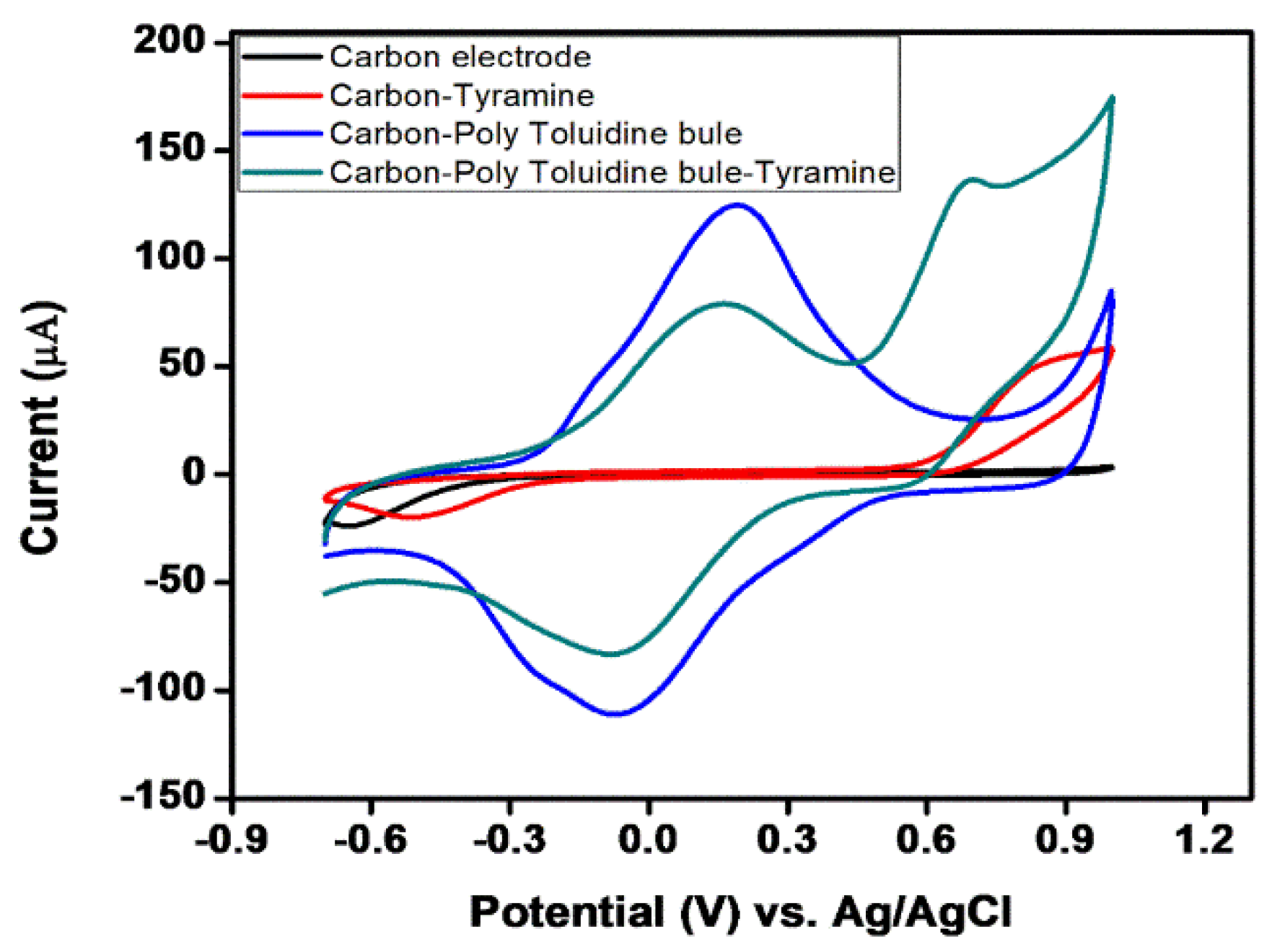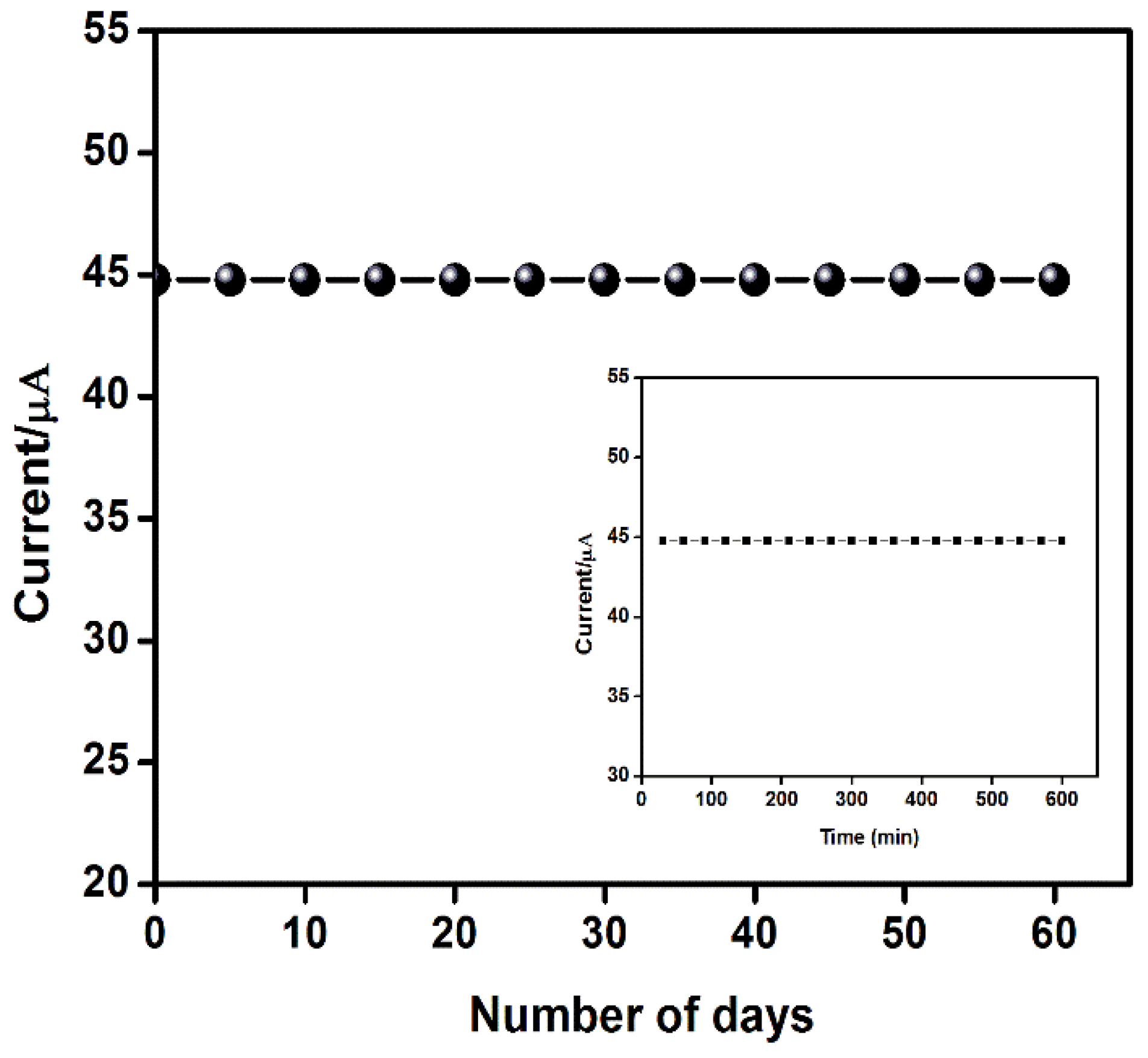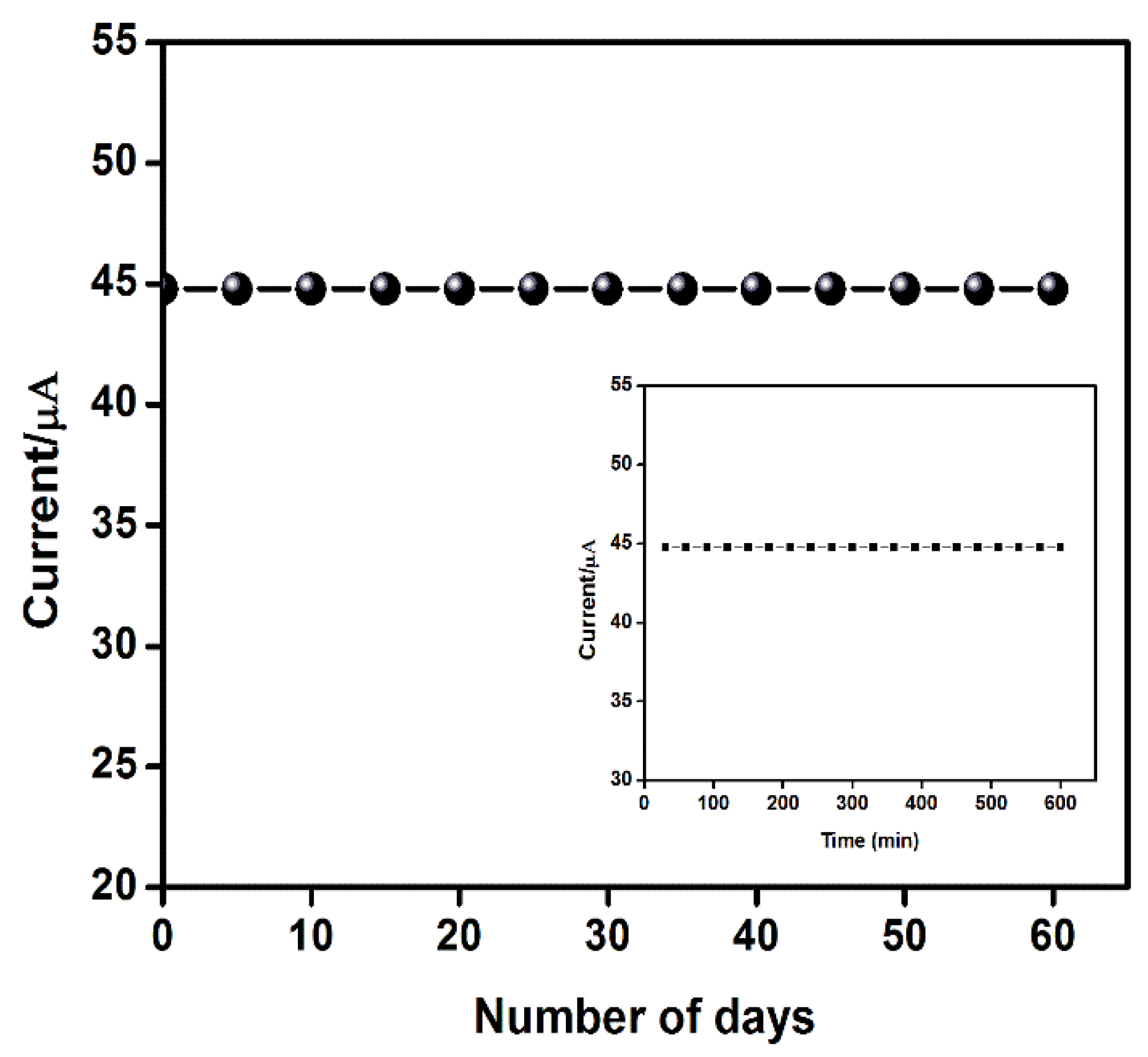Carbon Screen-Printed Electrode Coated with Poly (Toluidine blue) as an Electrochemical Sensor for the Detection of Tyramine †
Abstract
:1. Introduction
2. Materials and Methods
2.1. Reagents
2.2. Equipment
2.3. Poly (Toluidine blue) Coated Screen-Printed Electrode Preparation
3. Results and Discussion
3.1. Electrochemical Characterization of Poly (Toluidine blue) Screen Printed Carbon Electrode
3.2. Differential Pulse Voltammetry Studies
3.3. Long-Term Stability Studies
4. Conclusions
Author Contributions
Funding
Conflicts of Interest
References
- Atta, N.F.; Abdel-Mageed, A.M. Smart electrochemical sensor for some neurotransmitters using imprinted sol–gel films. Talanta 2009, 80, 511–518. [Google Scholar] [CrossRef] [PubMed]
- McCabe-Sellers, B.J.; Staggs, C.G.; Bogle, M.L. Tyramine in foods and monoamine oxidase inhibitor drugs: A crossroad where medicine, nutrition, pharmacy, and food industry converge. J. Food Compos. Anal. 2006, 19, 58–65. [Google Scholar] [CrossRef]
- Galgano, F.; Favati, F.; Bonadio, M.; Lorusso, V.; Romano, P. Role of biogenic amines as index of freshness in beef meat packed with different bio-polymeric materials. Food Res. Int. 2009, 42, 1147–1152. [Google Scholar] [CrossRef]
- Yoon, I.; Seo, K.; Lee, S.; Lee, Y.; Kim, B. Conformational study of tyramine and its water clusters by laser spectroscopy. J. Phys. Chem. A 2007, 111, 1800–1807. [Google Scholar] [CrossRef] [PubMed]
- Coloretti, F.; Chiavari, C.; Armaforte, E.; Carri, S.; Castagnetti, G. Combined use of starter cultures and preservatives to control production of biogenic amines and improve sensorial profile in low-acid salami. J. Agric. Food Chem. 2008, 56, 11238–11244. [Google Scholar] [CrossRef] [PubMed]
- García-Villar, N.; Hernández-Cassou, S.; Saurina, J. Characterization of wines through the biogenic amine contents using chromatographic techniques and chemometric data analysis. J. Agric. Food Chem. 2007, 55, 7453–7461. [Google Scholar] [CrossRef] [PubMed]
- Mohan, C.O.; Ravishankar, C.N.; Srinivasa Gopal, T.K.; Ashok Kumar, K.; Lalitha, K.V. Biogenic amines formation in seer fish (Scomberomorus commers on) steaks packed with O2scavenger during chilled storage. Food Res. Int. 2009, 42, 411–416. [Google Scholar] [CrossRef]
- Erdogana, Z.O.; Akinb, I.; Kucukkolbasi, S. new non-enzymatic sensor based on TiO2-Ag/polypyrrole forelectrochemical detection of tyramine. Synth. Met. 2018, 246, 96–100. [Google Scholar] [CrossRef]
- López, M.S.P.; Redondo-Gómez, E.; López-Ruiz, B. Electrochemical enzyme biosensors based on calcium phosphate materials for tyramine detection in food samples. Talanta 2017, 175, 209–216. [Google Scholar] [CrossRef] [PubMed]
- European Food Safety Authority Panel on Biological Hazards, Scientific opinion on risk based control of biogenic amine formation in fermented foods. Efsa J. 2011, 9, 2393–2396. [CrossRef]
- Calbiani, F.; Careri, M.; Elviri, L.; Mangia, A.; Pistarà, L.; Zagnoni, I. Rapid assayfor analyzing biogenic amines in cheese: Matrix solid-phase dispersion followed by liquid chromatography−electrospray−tandem mass spectrometry. J. Agric. Food Chem. 2005, 53, 3779–3783. [Google Scholar] [CrossRef] [PubMed]
- Gianotti, V.; Chiuminatto, U.; Mazzucco, E.; Gosetti, F.; Bottaro, M.; Frascarolo, P.; Gennaro, M.C. A new hydrophilic interaction liquid chromatography tandemmass spectrometry method for the simultaneous determination of seven biogenicamines in cheese. J. Chromatogr. A 2008, 1185, 296–300. [Google Scholar] [CrossRef]
- Xu, Z.; Okada, J.; Timerbaev, A.R.; Hirokawa, T. Sensitive profiling of biogenicamines in urine using CE with transient isotachophoretic preconcentration. J. Sep. Sci. 2009, 32, 4143–4147. [Google Scholar] [CrossRef]
- Ladero, V.; Martinez, N.; Martin, M.; Fernandez, M.; Alvarez, M. qPCR for quantitative detection of tyramine-producing bacteria in dairy products, Food Res. Int. 2010, 43, 289–295. [Google Scholar]
- Khana, M.Z.H.; Liua, X.; Zhua, J.; Ma, F.; Hua, W.; Liua, X. Electrochemical detection of tyramine with ITO/APTES/ErGO electrode andits application in real sample analysis. Biosens. Bioelectron. 2018, 108, 76–81. [Google Scholar] [CrossRef] [PubMed]
- Devi, C.L.; Narayanan, S.S. Poly(amido amine) dendrimer and silver nanoparticle–multi-walled carbon nanotubes composite with poly(neutral red)-modified electrode for the determination of ascorbic acid. Bull. Mater. Sci. 2019, 42, 73. [Google Scholar] [CrossRef]
- Lakshmi Devi, C.; Sriman Narayanan, S.; Sivaranjani, A. New electrochemical sensor for the detection of biological analytes using poly(amido amine) dendrimer and poly(Nile blue) modified electrode. J. Electroanal. Chem. 2019, 855, 113486. [Google Scholar]
- Devi, C.L.; Narayanan, S.S. Poly (amido amine) dendrimer/silver nanoparticles/multi-walled carbon nanotubes/poly (neutral red)-modified electrode for electrochemical determination of paracetamol. Ionics 2019, 25, 2323–2335. [Google Scholar] [CrossRef]
- Balasubramanian, S.; Tse-Wei, C.; Shen-Ming, C.; Karuppasamy, K.R.; Rajkumar, D.; Sea-Fue, W. Fabrication of Poly (Toluidine Blue O) Functionalized Multiwalled Carbon Nanotubes on Glassy Carbon Electrode for Hydrazine Detection. Int. J. Electrochem. Sci. 2018, 13, 4901–4910. [Google Scholar]
- Madalina, M.B.; Emilia, G.M.; Brett, C.M.A. Electrochemical sensors and biosensors based on redox polymer/carbon nanotube modified electrodes: A review. Anal. Chim. Acta 2015, 881, 1–23. [Google Scholar]




Publisher’s Note: MDPI stays neutral with regard to jurisdictional claims in published maps and institutional affiliations. |
© 2020 by the authors. Licensee MDPI, Basel, Switzerland. This article is an open access article distributed under the terms and conditions of the Creative Commons Attribution (CC BY) license (https://creativecommons.org/licenses/by/4.0/).
Share and Cite
Chakkarapani, L.D.; Brandl, M. Carbon Screen-Printed Electrode Coated with Poly (Toluidine blue) as an Electrochemical Sensor for the Detection of Tyramine. Eng. Proc. 2020, 2, 51. https://doi.org/10.3390/ecsa-7-08171
Chakkarapani LD, Brandl M. Carbon Screen-Printed Electrode Coated with Poly (Toluidine blue) as an Electrochemical Sensor for the Detection of Tyramine. Engineering Proceedings. 2020; 2(1):51. https://doi.org/10.3390/ecsa-7-08171
Chicago/Turabian StyleChakkarapani, Lakshmi Devi, and Martin Brandl. 2020. "Carbon Screen-Printed Electrode Coated with Poly (Toluidine blue) as an Electrochemical Sensor for the Detection of Tyramine" Engineering Proceedings 2, no. 1: 51. https://doi.org/10.3390/ecsa-7-08171
APA StyleChakkarapani, L. D., & Brandl, M. (2020). Carbon Screen-Printed Electrode Coated with Poly (Toluidine blue) as an Electrochemical Sensor for the Detection of Tyramine. Engineering Proceedings, 2(1), 51. https://doi.org/10.3390/ecsa-7-08171



